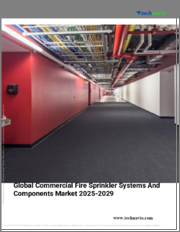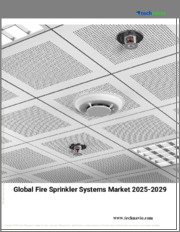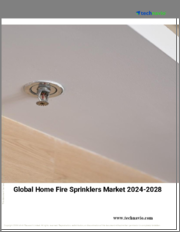
|
시장보고서
상품코드
1629094
소화용 스프링클러 파이프 시장 규모, 점유율, 성장 분석 : 소재별, 제품별, 최종사용자별, 지역별 - 산업 예측(2025-2032년)Fire Sprinkler Pipes Market Size, Share, Growth Analysis, By Material (Steel, Copper), By Product (Wet Pipe Systems, Dry Pipe Systems), By End-User, By Region - Industry Forecast 2025-2032 |
||||||
소화용 스프링클러 파이프 세계 시장 규모는 2023년에 21억 달러로 평가되며, 2024년에는 22억 3,000만 달러에서 2032년에는 36억 1,000만 달러로 성장할 것으로 예상되며, 예측 기간(2025-2032년) 동안 연평균 6.2%의 CAGR로 성장할 것으로 예상됩니다.
스프링클러 소화관 시장은 석유 및 가스, 광업, 석유화학 등 다양한 산업 분야의 엄격한 규제와 안전에 대한 관심 증가로 인해 크게 성장하고 있습니다. 일반적으로 탄소강이나 연성 철로 만들어진 이 파이프는 쉽게 식별할 수 있도록 빨간색으로 칠해야 하며, 가연성 물질이 있는 환경에서 화재 위험을 줄이기 위해 설계된 소화 시스템의 중요한 구성요소로 작용합니다. 화염을 효과적으로 냉각하고 산소를 대체하는 동시에 물 사용량을 줄여 성능을 향상시키고 있습니다. 화재 감지를 위해 열 복사를 이용하는 자동화 시스템의 지속적인 개선으로 시장 잠재력이 더욱 커지고 있습니다. 전 세계적으로 정부가 안전 규제를 강화함에 따라 고품질 소화용 스프링클러 파이프와 피팅에 대한 수요가 확대되고 있으며, 설비 품질 관리의 중요성이 부각되고 있습니다.
목차
소개
- 조사 목적
- 조사 범위
- 정의
조사 방법
- 정보 조달
- 2차 데이터와 1차 데이터 방법
- 시장 규모 예측
- 시장 가정과 제한
주요 요약
- 세계 시장 전망
- 공급과 수요 동향 분석
- 부문별 기회 분석
시장 역학과 전망
- 시장 개요
- 시장 규모
- 시장 역학
- 성장 촉진요인과 기회
- 성장 억제요인과 과제
- Porters 분석
주요 시장 인사이트
- 핵심성공요인
- 경쟁 정도
- 주요 투자 기회
- 시장 생태계
- 시장 매력 지수(2024년)
- PESTEL 분석
- 거시경제 지표
- 밸류체인 분석
- 가격 분석
- 사례 연구
- 규제 상황
- 특허 분석
- 무역 분석
소화용 스프링클러 파이프 시장 규모 : 소재별
- 시장 개요
- 강철
- 블랙 스틸
- 아연도금 강
- 구리
- CPVC(염소화 폴리염화비닐)
- PEX(가교 폴리에틸렌)
- 기타
소화용 스프링클러 파이프 시장 규모 : 제품별
- 시장 개요
- 웨트 파이프 시스템
- 드라이 파이프 시스템
- 사전 조치 시스템
- 딜루지 시스템
소화용 스프링클러 파이프 시장 규모 : 최종사용자별
- 시장 개요
- 주택
- 상업
- 산업
- 기관
소화용 스프링클러 파이프 시장 규모
- 북미
- 미국
- 캐나다
- 유럽
- 독일
- 스페인
- 프랑스
- 영국
- 이탈리아
- 기타 유럽
- 아시아태평양
- 중국
- 인도
- 일본
- 한국
- 기타 아시아태평양
- 라틴아메리카
- 브라질
- 기타 라틴아메리카
- 중동 및 아프리카
- GCC 국가
- 남아프리카공화국
- 기타 중동 및 아프리카
경쟁 정보
- 상위 5개사의 비교
- 주요 기업의 시장 포지셔닝(2024년)
- 주요 시장 기업이 채용한 전략
- 시장의 최근 동향
- 기업의 시장 점유율 분석(2024년)
- 주요 기업 개요
- 기업 개요
- 제품 포트폴리오 분석
- 부문별 점유율 분석
- 매출 전년비 비교(2022-2024)
주요 기업 개요
- Tyco International(USA)
- Viking Group Inc.(USA)
- Spears Manufacturing Co.(USA)
- GF Piping Systems(Switzerland)
- Aquatherm GmbH(Germany)
- TPMCSTEEL(China)
- Wheatland Tube(USA)
- Reliance Worldwide Corporation(Australia)
- Aliaxis Group(Belgium)
- Uponor Corporation(Finland)
- Zurn Industries, LLC(USA)
- NIBCO Inc.(USA)
- Mueller Industries, Inc.(USA)
- Tianjin Pipe Corporation(China)
- Charlotte Pipe and Foundry Company(USA)
- McWane, Inc.(USA)
결론과 추천사항
KSM 25.02.11Global Fire Sprinkler Pipes Market size was valued at USD 2.1 billion in 2023 and is poised to grow from USD 2.23 billion in 2024 to USD 3.61 billion by 2032, growing at a CAGR of 6.2% during the forecast period (2025-2032).
The fire sprinkler pipe market is witnessing significant growth, driven by stringent regulations and heightened safety concerns across various industries, including oil and gas, mining, and petrochemicals. Typically made from carbon steel or ductile iron, these pipes, mandated to be painted red for easy identification, serve as critical components in firefighting systems designed to mitigate fire risks in environments with flammable materials. Recent advancements, such as HI-FOG technology, enhance performance by reducing water usage while effectively cooling flames and displacing oxygen. Continuous improvements in automated systems utilizing thermal radiation for fire detection further boost market potential. As governments globally enforce stricter safety regulations, the demand for high-quality fire sprinkler pipes and fittings is set to expand, underscoring the importance of quality control in installations.
Top-down and bottom-up approaches were used to estimate and validate the size of the Global Fire Sprinkler Pipes market and to estimate the size of various other dependent submarkets. The research methodology used to estimate the market size includes the following details: The key players in the market were identified through secondary research, and their market shares in the respective regions were determined through primary and secondary research. This entire procedure includes the study of the annual and financial reports of the top market players and extensive interviews for key insights from industry leaders such as CEOs, VPs, directors, and marketing executives. All percentage shares split, and breakdowns were determined using secondary sources and verified through Primary sources. All possible parameters that affect the markets covered in this research study have been accounted for, viewed in extensive detail, verified through primary research, and analyzed to get the final quantitative and qualitative data.
Global Fire Sprinkler Pipes Market Segmental Analysis
Global Fire Sprinkler Pipes Market is segmented by Material, Product, End-User and region. Based on Material, the market is segmented into Steel, Copper, CPVC (Chlorinated Polyvinyl Chloride), PEX (Cross-linked Polyethylene) and Others. Based on Product, the market is segmented into Wet Pipe Systems, Dry Pipe Systems, Pre-action Systems and Deluge Systems. Based on End-User, the market is segmented into Residential, Commercial, Industrial and Institutional. Based on region, the market is segmented into North America, Europe, Asia Pacific, Latin America and Middle East & Africa.
Driver of the Global Fire Sprinkler Pipes Market
The Global Fire Sprinkler Pipes market is primarily driven by stringent government regulations, which mandate the installation of fire safety systems in various types of structures. With heightened awareness surrounding safety and the increasing investments in advanced, smart technologies, the demand for fire sprinkler pipes continues to grow. For instance, the NFPA-13 regulations in the United States require that all newly constructed commercial buildings exceeding 5,000 square feet incorporate fire sprinkler systems. This regulatory compliance, coupled with a heightened focus on safety measures, fuels the expansion of the fire sprinkler market, ultimately enhancing fire protection across various sectors.
Restraints in the Global Fire Sprinkler Pipes Market
One of the significant restraints facing the Global Fire Sprinkler Pipes market is the substantial financial investment required for the installation and ongoing maintenance of fire protection systems. The complexities involved in establishing these networks demand considerable initial capital. Additionally, the continuous development and upgrading of advanced technologies to effectively address fire emergencies further contribute to the high costs. Vendors are compelled to invest extensively in research and development to enhance their offerings, which, in turn, translates into elevated procurement expenses for both businesses and government entities aiming to ensure comprehensive fire safety for their infrastructures.
Market Trends of the Global Fire Sprinkler Pipes Market
The Global Fire Sprinkler Pipes market is experiencing significant growth, driven by heightened automation trends in commercial buildings and the escalating costs associated with fire safety for enterprises and government institutions. With organizations increasingly focusing on safeguarding their infrastructure, investments in advanced fire protection systems have surged. Furthermore, the shift towards automation not only enhances safety protocols but also streamlines maintenance processes, thus creating substantial opportunities for market expansion. As regulations become more stringent and awareness of fire safety escalates, the demand for innovative fire sprinkler pipe solutions is set to surge, positioning the industry for robust growth in the near future.
Table of Contents
Introduction
- Objectives of the Study
- Scope of the Report
- Definitions
Research Methodology
- Information Procurement
- Secondary & Primary Data Methods
- Market Size Estimation
- Market Assumptions & Limitations
Executive Summary
- Global Market Outlook
- Supply & Demand Trend Analysis
- Segmental Opportunity Analysis
Market Dynamics & Outlook
- Market Overview
- Market Size
- Market Dynamics
- Drivers & Opportunities
- Restraints & Challenges
- Porters Analysis
- Competitive rivalry
- Threat of substitute
- Bargaining power of buyers
- Threat of new entrants
- Bargaining power of suppliers
Key Market Insights
- Key Success Factors
- Degree of Competition
- Top Investment Pockets
- Market Ecosystem
- Market Attractiveness Index, 2024
- PESTEL Analysis
- Macro-Economic Indicators
- Value Chain Analysis
- Pricing Analysis
- Case Studies
- Regulatory Landscape
- Patent Analysis
- Trade Analysis
Global Fire Sprinkler Pipes Market Size by Material & CAGR (2025-2032)
- Market Overview
- Steel
- Black Steel
- Galvanized Steel
- Copper
- CPVC (Chlorinated Polyvinyl Chloride)
- PEX (Cross-linked Polyethylene)
- Others
Global Fire Sprinkler Pipes Market Size by Product & CAGR (2025-2032)
- Market Overview
- Wet Pipe Systems
- Dry Pipe Systems
- Pre-action Systems
- Deluge Systems
Global Fire Sprinkler Pipes Market Size by End-User & CAGR (2025-2032)
- Market Overview
- Residential
- Commercial
- Industrial
- Institutional
Global Fire Sprinkler Pipes Market Size & CAGR (2025-2032)
- North America (Material, Product, End-User)
- US
- Canada
- Europe (Material, Product, End-User)
- Germany
- Spain
- France
- UK
- Italy
- Rest of Europe
- Asia Pacific (Material, Product, End-User)
- China
- India
- Japan
- South Korea
- Rest of Asia-Pacific
- Latin America (Material, Product, End-User)
- Brazil
- Rest of Latin America
- Middle East & Africa (Material, Product, End-User)
- GCC Countries
- South Africa
- Rest of Middle East & Africa
Competitive Intelligence
- Top 5 Player Comparison
- Market Positioning of Key Players, 2024
- Strategies Adopted by Key Market Players
- Recent Developments in the Market
- Company Market Share Analysis, 2024
- Company Profiles of All Key Players
- Company Details
- Product Portfolio Analysis
- Company's Segmental Share Analysis
- Revenue Y-O-Y Comparison (2022-2024)
Key Company Profiles
- Tyco International (USA)
- Company Overview
- Business Segment Overview
- Financial Updates
- Key Developments
- Viking Group Inc. (USA)
- Company Overview
- Business Segment Overview
- Financial Updates
- Key Developments
- Spears Manufacturing Co. (USA)
- Company Overview
- Business Segment Overview
- Financial Updates
- Key Developments
- GF Piping Systems (Switzerland)
- Company Overview
- Business Segment Overview
- Financial Updates
- Key Developments
- Aquatherm GmbH (Germany)
- Company Overview
- Business Segment Overview
- Financial Updates
- Key Developments
- TPMCSTEEL (China)
- Company Overview
- Business Segment Overview
- Financial Updates
- Key Developments
- Wheatland Tube (USA)
- Company Overview
- Business Segment Overview
- Financial Updates
- Key Developments
- Reliance Worldwide Corporation (Australia)
- Company Overview
- Business Segment Overview
- Financial Updates
- Key Developments
- Aliaxis Group (Belgium)
- Company Overview
- Business Segment Overview
- Financial Updates
- Key Developments
- Uponor Corporation (Finland)
- Company Overview
- Business Segment Overview
- Financial Updates
- Key Developments
- Zurn Industries, LLC (USA)
- Company Overview
- Business Segment Overview
- Financial Updates
- Key Developments
- NIBCO Inc. (USA)
- Company Overview
- Business Segment Overview
- Financial Updates
- Key Developments
- Mueller Industries, Inc. (USA)
- Company Overview
- Business Segment Overview
- Financial Updates
- Key Developments
- Tianjin Pipe Corporation (China)
- Company Overview
- Business Segment Overview
- Financial Updates
- Key Developments
- Charlotte Pipe and Foundry Company (USA)
- Company Overview
- Business Segment Overview
- Financial Updates
- Key Developments
- McWane, Inc. (USA)
- Company Overview
- Business Segment Overview
- Financial Updates
- Key Developments



















